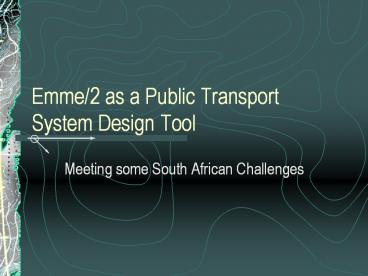Emme/2 as a Public Transport System Design Tool - PowerPoint PPT Presentation
1 / 23
Title:
Emme/2 as a Public Transport System Design Tool
Description:
Emme/2 Conference South Africa 2004 9 ... Emme/2 Conference South Africa 2004 10. Mark network links according to a policy structure. ... – PowerPoint PPT presentation
Number of Views:207
Avg rating:3.0/5.0
Title: Emme/2 as a Public Transport System Design Tool
1
Emme/2 as a Public Transport System Design Tool
- Meeting some South African Challenges
2
The Process in Perspective
- The Emme/2 modelling approach presented here is
the first, and potentially standalone phase, of a
three step public transport modelling process
incorporating - Integrated, multi-modal network modelling of all
transport demand. - Empirical conversion of network model output to
route definitions. - Multi-objective allocation of resources to public
transport design.
3
The Objective.
- A practical design tool for guiding South African
government transport policies with respect to - Integrated metropolitan transport plans.
- Promotion of public transport.
- Tendered public transport services.
- Empowerment of small operators.
- Rationalisation Plans.
- Operating Licence Strategies.
4
Underlying Design Principles.
- Public transport must be planned as an integral
part of the overall transport system. - Route design must approximate private mode travel
patterns. - Public transport system design must be mode
independent. - Resources must be efficiently used.
- The most efficient system is not necessarily the
most efficient application of any one system
component.
5
(No Transcript)
6
Route Design Considerations.
- Routes must satisfy demand.
- Routes must follow the paths chosen by customers.
- Service frequency should be matched across entire
system and be attractive to customers. - Routes should be self-sustaining.
- Technology used should match demand.
7
Preparing the Network Model.
- Obtain public transport demand matrices.
- Temporal matrices with Growth factor the public
transport design cycle is one week, not the
morning peak period. - Establish a design value for transit vehicle
occupancy. - Set policy attributes for all links.
- Set volume delay functions for ALL links on
network. - Modify mode definitions to make transit the
primary mode.
8
Demand Matrices
- Public transport demand matrices, based on
household surveys and allowing for some marginal
growth in demand according to zone attributes - Separate out potential express demand based on
minimum O-D demand levels and distance - Potential Express demand
- Regular demand
9
Vehicle Occupancy.
- Establish the capacity of one passenger car
equivalent, road-based public transport vehicle. - One 60-seat bus ? 4 passenger car units.
- ?Vehicle occupancy ? 60/4 15.
- One 14 seat taxi ? 1 passenger car unit.
- ?Vehicle occupancy ? 14.
- Use 14 passengers as average vehicle occupancy
rate.
10
Policy Attributes.
- Mark network links according to a policy
structure. For example - Promote public transport on some links.
- Discourage public transport on some links.
- Links used in spite of discouraging policy may
require functional re-evaluation. - Never disallow public transport on any link.
11
Volume Delay Functions.
- All links carrying public transport must have
volume delay functions. - For road and pedestrian modes, these will be
conventional functions. - Non-road mode functions must account for
- Vehicle occupancy global occupancy rate not
applicable. - System capacities travel time independent of
demand. - Technical factors minimum headway.
12
The Network Modelling Process.
- Generalised-cost, multi-modal, multi-class
assignment of all demand on network with transit
demand as primary class. - Extraction of travel times from multi-class
assignment. - Extraction of potential express demand from
demand matrices. - Iterative generalised-cost, multi-modal, single
class assignment to focus public transport travel
paths.
13
Generalised-cost Function for Public Transport.
- Users perceive a cost of travel on each link as
a function of a number of factors - Travel time perceived equally by all users.
- Link length / fare component introduces modal
cost differences. - Demand penalty encourages users to travel in
groups. - Policy factor promotes or discourages use of
certain links.
14
Demand Penalties.
- Demand penalties applied to motorised links only.
- Demand penalty increases with
- Decreasing two-way link volume.
- Decreasing directional balance.
- Increasing disparity in demand between operating
periods. - Determined using a Link Index.
15
The Link Index.
The general form for the link index LI.
16
Determining the Demand Penalty.
- For a single operating period model
- Demand Penalty DP (MF / LI) 0.9
- For a multiple operating period model
- Demand Penalty DP (MF / CLI)) 0.9
17
The Focusing Process.
- Determine link indices for each motorised link in
each operating period. - Determine the composite link index for each link.
- Determine the demand penalty for each link.
- Determine the new fixed cost.
- Weight of fixed cost 0.1 to avoid domination.
- Re-assign public transport demand with new
Generalised Cost.
18
Multi-class Assignment Output.
19
Express Routes.
20
Before Focusing.
21
First Focusing Step
22
Second Focusing Step
23
Third Focusing Step
24
After Four Focusing Steps.
Dedicated ROW ?
Bus
Mini-Bus
25
Interpreting the results 1
- Blue lines are relatively low volume less that
100 people per hour in peak Use mini-bus class
vehicles. - Green lines indicate sufficient volume to justify
use of larger buses, in this case, mainly
standard buses. - Red lines indicate that consideration should be
given to dedicated right of way.
26
Interpreting the results 2
- The data gives an indication of where the various
modes should be employed and estimates of the
demand levels. - This gives guidance to
- Rationalisation plans
- Operating Licence Strategies
- New multi-class assignment using final
generalised costs will give system operating
conditions for all users integrated transport
plan!
27
Outcomes Further Development
- Provides a structured approach to public
transport planning in SA conditions. - Readily observable results.
- Relatively simple to implement.
- Need to introduce variable demand modelling.
- THANK YOU

